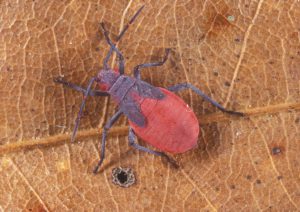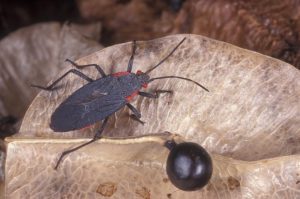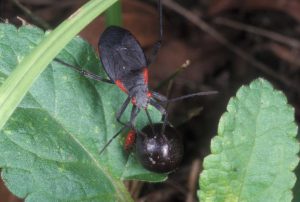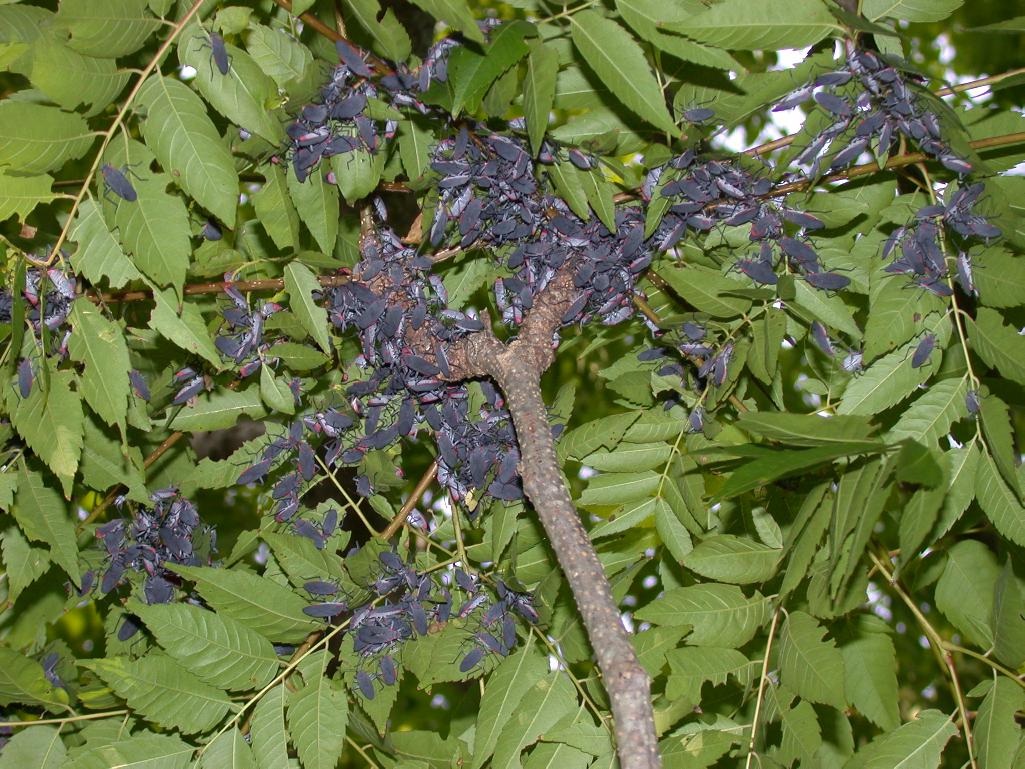This is a guest post by Mark Wilhelm, an undergraduate student and research assistant in the Dale Lab at the University of Florida Entomology and Nematology Department.
Florida homeowners are often left puzzled and concerned when they see massive numbers of black and red bugs appear around their yards or on the side of their home, wondering what they are, where they came from, and how they became so numerous. One common culprit in the southern U.S. and Central America is the scentless plant bug or Jadera bug (Jadera haematoloma), which is particularly abundant in late spring through summer.


These bugs often aggregate together in huge groups, becoming a real nuisance. The nymphs, or immature stages, are wingless and mostly red with a black thorax, head, legs, and antennae. The adults are similarly colored, with black wings and red shoulders. Scentless plant bugs are frequently confused with boxelder bugs (Boisea trivittata), which also show up in large numbers in landscapes and on home walls and windows, but have a red line behind the head and red edges on their wings.

What do they eat?
This scentless plant bug feeds on the seeds of several groups of plants which have fallen to the ground. As a result, they are often found in large numbers in leaf litter and around trees. Sometimes they feed on figs (Ficus) and marsh-mallows (Althaea). Yes, that is a plant—and no, it does not grow white, puffy, gooey fruit.

Their favorite host plants by far are those in the family Sapindaceae, or the soapberry family. One of these, the balloonvine (Cardiospermum corindum), is native to south Florida, and is the scentless plant bug’s primary native host. Another favorite host plant of this bug, the goldenrain tree (Koelreuteria elegans), is in the same family, but was introduced to Florida and has become an invasive species. The goldenrain tree, native to Taiwan, was widely planted because of its beautiful yellow flowers and rose-colored fruit. However, it was a bad idea—now the golden raintree has been naturalized in 11 Florida counties, is invading conservation lands throughout the state, and is classified as a Category II invasive plant by the Florida Exotic Pest Plant Council (FLEPPC). As if that wasn’t enough, scentless plant bugs flock to it like—well, like scentless plant bugs to a goldenrain tree. The association between these two is so strong that the insect is sometimes called the goldenrain tree bug. There is even evidence that, since the introduction of the goldenrain tree, this native insect’s mouthparts have become shorter as an adaptation to feed on this plant’s seeds, which are smaller than those of the native balloonvine. Bug populations that have adapted to the introduced host also produce more offspring and have higher survival rates on goldenrain tree than they do when feeding on the native balloonvine.

Plants in the soapberry family (Sapindaceae) contain toxic compounds called cyanolipids, which the scentless plant bug sequesters and uses as a chemical defense against predators. Possibly because of this defense, the scentless plant bug, like other insects in the family Rhopalidae, has lost the defensive scent glands that most other related bugs (in the suborder Heteroptera) possess, hence the name scentless.
Interestingly, scentless plant bugs were shown to excrete another chemical compound called a lactone that is attractive to other scentless plant bug individuals, but they only excrete this when they feed on goldenrain tree seeds. This may be a useful adaptation for wild populations, since the goldenrain tree has higher seed production in a shorter period of time than balloonvine. These chemical cues enable scentless plant bugs to effectively aggregate around goldenrain trees during the window of time when seeds are being produced. It certainly helps to explain why the bugs swarm like the plague when a goldenrain tree is nearby.

Anything to be concerned about?
Scentless plant bugs do not cause damage to cultivated plants, but they can be a real nuisance around the home. They can be managed to some extent by raking areas around their host plants to remove seeds. At any rate, goldenrain trees should not be planted because they are an invasive species and threaten our native ecosystems. Therefore, as with many other insects, a good first step to managing these potential pests is proper plant selection. If trouble persists, contact your local IFAS Extension office for guidance on the best path forward.
Curious about this insect or others common around your home landscape? Check out the ‘Helpful, Harmful, Harmless’ identification booklet at the UF IFAS Extension bookstore.
More useful resources:
http://entnemdept.ufl.edu/creatures/trees/jadera_bugs.htm
http://www.soapberrybug.org/01_cms/details.asp?ID=65
 2
2
